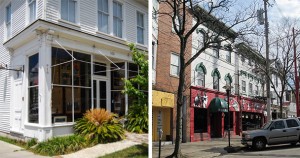Green building design standards have been around since the early 1990s. The movement has grown to become the most important and progressive trend in the building industry, but community-wide projects are still few and far between. How can we create sustainable communities that will be good for all people throughout time?
To spur the development of more green communities, the International Living Future Institute is challenging developers, urban planners, architects, and contractors to work together to rethink the relationship of the built and natural environments.
Living Community Challenge 1.0 is an attempt to apply the initiatives established by the Living Building Challenge on a community-wide scale. It places greater importance on resilient infrastructure, imagining an entire community designed and constructed to function as an ecosystem, able to generate its own energy through renewable resources, capture and treat all of its water, and operate in an efficient and beautiful way

LCC recognizes that different settings require different development. It is based on The Living Transect, an adaptation of the original concept of the Rural-to-Urban Transect, but which emphasizes appropriate mixed-use development in zones L3 and L4.
Green performance is encouraged through two levels of certification. A master plan or built project can earn Living Community Certification by meeting twenty imperatives across seven “Petals,” whereas a community can earn Petal Community Certification if it meets all the imperatives of at least three of the seven performance area “Petals”— Place, Water, Energy, Health and Happiness, Materials, Equity, and Beauty and Spirit. ILFI says that projects that achieve this level of performance can claim to be the ‘greenest’ anywhere, and will serve as role models for others that follow.
The main image above shows a watercolor of the Hercules Bayfront transit-oriented development. The bayfront is part of the Central Hercules Plan, which organizes over 1,200 units and 250,000 square feet of mixed-use space into three distinct walkable neighborhoods and integrates a number of significant public amenities, including a new Amtrak Station on the Capitol Corridor line and a potential new Water Transit Authority ferry terminal. Opticos led a team to write a regulating plan for the Hercules Bayfront neighborhood that includes a mixed-use retail and commercial district along the waterfront and a series of district neighborhoods that integrate housing types, from townhomes to mid-rise condos. The plan earned LEED-ND Gold Certification, another rating system for green neighborhoods.
“The shared economy is absolutely turning on its head the way we use our assets in the community,” said Rob Bennett, CEO of EcoDistricts, a group that aims to create sustainable cities from the neighborhood up. “We need to make sure the tools we are inventing are inviting of that creativity, and innovation needs to be part of city planning … Primarily it’s about flexibility. It’s about being able to interconnect over time.”
Read more about Living Community Challenge 1.0 here.